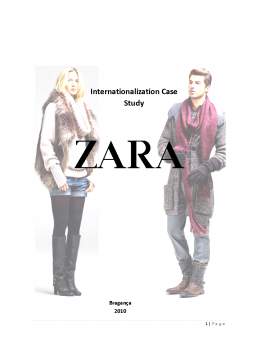Cuprins
- 1. Brief story of Zara company 3
- 2. Why/How Zara internationalized 4
- 3. Marketing Mix 6
- 3.1. Product 6
- 3.2. Price 8
- 3.3. Promotion 8
- 3.4. Placement 9
- References 10
Extras din referat
1. Brief story of Zara Company
ZARA is the flagship chain store of Inditex Group owned by Spanish company tycoon Amancio Ortega, who also owns brands such as Massimo Dutti, Pull and Bear, Oysho, Uterqüe, Stradivarius and Bershka.
The origins of Inditex go back to 1963. Its founder, owner and chairman, Amancio Ortega, started to manufacture housecoats in Arteixo, near A Coruña (Spain). The business grew steadily throughout the decade to include several manufacturing centres distributing products to various European countries.
In 1973, Zara was born and in 1975 the first store opened in A Coruña. Since that date, the history of Inditex is the history of a continuous success. The Zara fashion concept worked well and stores mushroomed in Spain. The sustained growth of the young firm lead its managers to create Inditex (the head of the group) and to develop a logistic system very much inspired in the Japanese just-in-time model.
The Zara fashion chain, founded in 1975 in Arteixo, a small town in the north of Spain, is perhaps the world's most successful clothing chain. Zara has helped its parent, the Spanish firm Inditex, grow from obscurity in the mid 90s to the world's third largest pure-play fashion retailer after the Swedish H&M and US-based Gap Inc. with financial performance well ahead of these rivals.
Zara was described by Louis Vuitton fashion director, Daniel Piette, as "possibly the most innovative and devastating retailer in the world." Zara has also been described as a "Spanish success story" by CNN.
The Spanish firm not only sells clothes but also designs and makes them. As it makes the clothes itself, it can react quickly to changing market trends. While others, including rivals Gap and H&M, take up to nine months to get new lines into their shops, Zara takes just two to three weeks.
2. Why/How Zara Internationalized
Usually the internationalization process is motivated by two factors:
- Push factor are those that encourage an organization to search for international opportunities. In this case, Zara’s internationalization was encouraged by the liberalization of economy that started when Spain entered in The European Economic Community. That was the first opportunity to an economy of scale and globalization.
- Pull factor involve attractive conditions in the host market, like maturity of market, changes in consumer behavior, etc.
The sustained growth of the young firm lead its managers to create Inditex (the head of the group) and to develop a logistic system very much inspired in the Japanese just-in-time model. Zara’s internationalization started in 1988, as one store in Porto, Portugal, opened. In less than 20 years, the firm has expanded through 62 countries.
Zara behavior in selecting its overseas markets for internationalization is discussed in three phases:
1. Reluctance and trial (1975-1988) which is experience acquiring phase and started with opening the first abroad store in Portugal, Porto.
2. Captious expansion (1989-1996) that during this phase, Zara added one or two similar socio-economic countries per year to its markets.
3. Aggressive expansion (1997-2005). In this phase Zara practiced global expansion in many countries regardless of socio-economic similarities.
Preview document
Conținut arhivă zip
- Internationalization Case Study - ZARA.docx


















